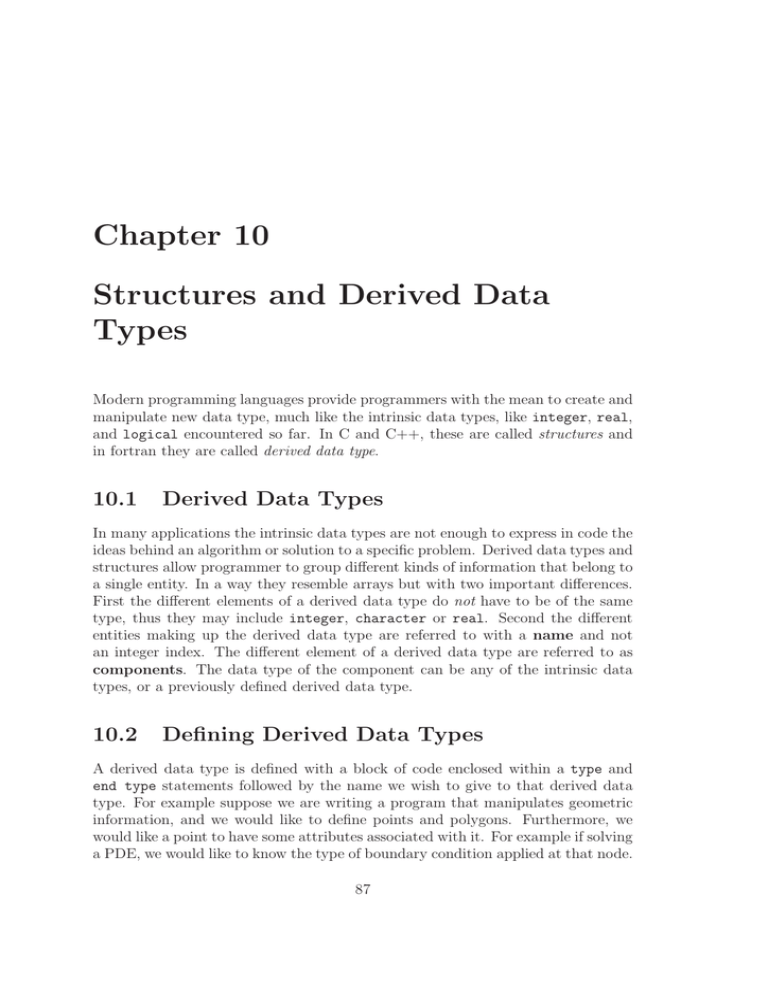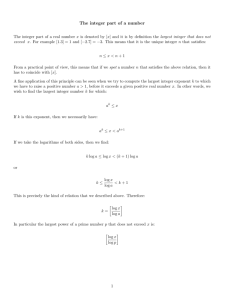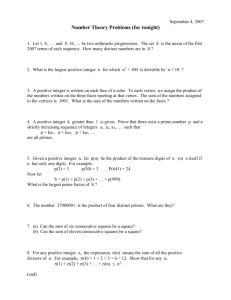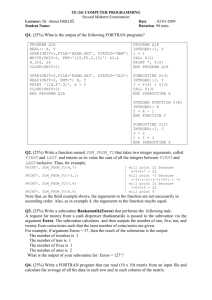Chapter 10 Structures and Derived Data Types
advertisement

Chapter 10 Structures and Derived Data Types Modern programming languages provide programmers with the mean to create and manipulate new data type, much like the intrinsic data types, like integer, real, and logical encountered so far. In C and C++, these are called structures and in fortran they are called derived data type. 10.1 Derived Data Types In many applications the intrinsic data types are not enough to express in code the ideas behind an algorithm or solution to a specific problem. Derived data types and structures allow programmer to group different kinds of information that belong to a single entity. In a way they resemble arrays but with two important differences. First the different elements of a derived data type do not have to be of the same type, thus they may include integer, character or real. Second the different entities making up the derived data type are referred to with a name and not an integer index. The different element of a derived data type are referred to as components. The data type of the component can be any of the intrinsic data types, or a previously defined derived data type. 10.2 Defining Derived Data Types A derived data type is defined with a block of code enclosed within a type and end type statements followed by the name we wish to give to that derived data type. For example suppose we are writing a program that manipulates geometric information, and we would like to define points and polygons. Furthermore, we would like a point to have some attributes associated with it. For example if solving a PDE, we would like to know the type of boundary condition applied at that node. 87 88 CHAPTER 10. STRUCTURES AND DERIVED DATA TYPES A point data type in 2D space can thus be defined: type :: point real :: x(2) integer :: bccode end type point ! coordinates of point in 2D space ! boundary condition code The components of point are a real vector x of dimension 2, and an integer bccode. Once a type has been declared it can be used to declare variables of that type. For example the following code declares two variables, A and B and C, of type point: type(point) :: A,B,C A = point( (/0.0,0.0/), 0) ! constructor for point A B = point( (/1.0,0.0/), 0) ! constructor for point B C = point( (/0.0,1.0/), 0) ! constructor for point C The statement A = point( (/0.0,0.0/), 0) is a default constructor for data type point. The constructor is essentially like a function call whose name is that of the derived data type, and whose argument consist of the data type component listed in the order of their declaration in the data type definition; in this case it is the vector of real followed by the integer. One can also define arrays of derived data type, for example type(point) :: circle(64) declares an 1D array of points of size 64. A derived data type can be used as a component within another data type. For example, a polygon can now be defined as a collection of points, as in the following code: type :: polygon integer :: nnodes type(point), allocatable :: pointlist(:) end type polygon In this case the component consist of the number of points in the polygon and an allocatable array of \verb-point- types. 10.3 Working with Derived Data Type Each component of a derived data type can be addressed independently and used just like any other variable of the same type. If the component is an integer, it can be used like any other integer, and so forth. A component is specified with a component selector, which consists of the name of the variable followed by a percent sign % then by the component name. For example the following sets the coordinates of the variable A 10.4. MEMORY ALLOCATION FOR DERIVED DATA TYPE 89 A%x(1) = 2.0 A%x(2) = A%x(1) + 2.0 To address a component within an array of a derived data type, place the array index after the array name and before the component selector; for example circle(j)%bccode selects the first entry of component bccode belonging to the j-th entry of array circle. To address a component of a derived data type that is included within another derived data type, simply concatenate their names separated by a percent signs. Thus the coordinates of the second point in polygon polyg can be addressed as: polyg%pointlist(2)%x = (\2.0, 3.0\) 10.4 Memory Allocation for Derived Data Type When a variable of a derived data type is declared, the compiler has to allocate memory to all its components. The addresses of these components are not required to be in successive memory locations. Instead, the compiler is free to put the addresses in any location so it has enough leeway to optimize the memory access. However, sometime a strict order of memory allocation is important (for example when passing the structure to a procedure written in a different programming language). If the element of a derived data type must be allocated in consecutive memory location for some reason, a SEQUENCE statement must be included in the derived data type definition. An example is type :: point sequence real :: x(2) integer :: bccode end type polygon 10.5 Derived Data Type Declaration in Modules The definition of a derived data type can be fairly bulky, and must be included in every procedure that uses variables of that type. To avoid the problem of duplicate declaration, it is most useful to define new data types in a module data section, and then to use the module in every procedure needing the data type. If the data type need modification, the changes to the definition can be performed in a single module and propagated throughtout the code with the help of the use statement. Chapter 11.1 will present the use of modules for more effetive programming in more details. 90 CHAPTER 10. STRUCTURES AND DERIVED DATA TYPES Chapter 11 Modules 11.1 Data Encapsulation Modules are powerful tools that simplify the tasks of building complex large programs. Although we have encountered modules before we have not explored their full potential. This chapter explores some of the more advanced module constructs. We will use the example of derived data types to motivate and illustrate the use of these constructs. Although it is easy to work with the components of a variable of a derived data type, it is not easy to work with the variables of derived data type as a whole. It is legal to assign one variable of given derived data type to another variable of the same type, essentially a copy operations of all the components, but other intrinsic operators, such as additions, substraction or multiplication are not defined. Operator overloading is one mechanism to define such operations on derived data types. There is anoter reason where module use is important for derived data type: encapsulation. Encapsulation is the concept of packaging data and the methods that are used to manipulate that data is grouped together. The data and the methods would then be defined in the same module, and encapsulation requires that access to the data is done solely through the methods provided, i.e. through subroutine and function calls. In objected-oriented languages this packaging of data and methods is called a class. The encapsulation allows programmer to control access to the data types through interfaces. Changes to the data types, and the methods that manipulate them can be confined to one module that can be easily maintained, and are transparent to the procedure using those entities. The points module shown in figure 11.1 is an example of a class which includes the data definition, the point derived type, and the methods that are used to operate on the class. These include querying and setting the various data components making up the derived type point. The contains statement separates the data declaration portion of a module from the procedures included in the module. In 91 92 CHAPTER 11. MODULES module points implicit none integer, parameter :: sdim type :: point ! begin derived type definition real :: x(sdim) ! coordinate of points integer :: bccode ! some information about this node end type point ! end derived type definition contains !******************************************************************************* subroutine GetCoordinate(pA, xc) type(point), intent(in) :: pA real, intent(out) :: xc(sdim) xc = pA%x ! retrieves the coordinates of a point return end subroutine GetCoordinate !******************************************************************************* integer function GetBCCode(pA) type(point), intent(in) :: pA GetBCCode = pA%bccode ! retrieves the BC code of a point end integer GetBCCode !******************************************************************************* subroutine SetCoordinate(pA, xc) real, intent(in) :: xc(sdim) type(point), intent(inout) :: pA pA%x = xc ! sets the coordinates of a point end subroutine SetCoordinate !******************************************************************************* subroutine SetBCCode(pA, bccode) implicit none type(point), intent(inout) :: pA integer, intent(in) :: bccode pA%bccode = bccode ! sets the boundary condition code of a point end subroutine GetBCCode !******************************************************************************* subroutine PrintPoint(pA,unit) integer, intent(in) :: unit ! file unit to write to. type(point), intent(in) :: pA ! point to write write(unit,*) pA%x, pA%bccode return end subroutine PrintPoint !******************************************************************************* subroutine ReadPoint(pA,unit) integer, intent(in) :: unit ! file unit to read from type(point), intent(in) :: pA ! point to write read(unit,*) pA%x, pA%bccode return end subroutine ReadPoint end module points Figure 11.1: Point Module 11.2. PRIVATE AND PUBLIC ACCESS 93 program triangle use points implicit none type(point) :: tri(3) call SetCoordinate(tri(1), (/0.0, 0.0/) ); call SetBCCode(tri(1), 1) call SetCoordinate(tri(2), (/0.0, 1.0/) ); call SetBCCode(tri(1), 2) call SetCoordinate(tri(3), (/1.0, 0.0/) ); call SetBCCode(tri(1), 3) end program triangle the present instance the data portion is used to declare the points data type. A main code wishing to use the methods included in the module would simply use the module. For example the following code code declares an array of three points, to represent a triangle, iniatilizes them and calculates the area of the triangle. 11.2 Private and Public Access All variables and procedures defined in a module have their access set to public by default. That is procedures that use a module have access to all its data procedures. The initialization of the points in the triangle could have been done as follows: tri(1)%x(1)=0.0; tri(1)%x(2)=0.0; tri(1)%bccode=1; This statement, however, although permissible contradicts the principle of data hiding and encapsulation. The implementation of the data type is now visible to all part of the program, and changing (for whatever reason) later on would require changes to all parts of the code. In order to prevent other programmers to have access to the class implementation, it is useful to restrict access to the class’ internal data. Access control to the data and procedure of a module is possible through the public and private statements. These statements can be used either as stand alone to declare the entire scope as either public or private, or they can be used as attributes to declare variables as public or private. 11.2.1 Access in type declaration The following declaration restricts access of the members of a data type to the module where the data type is defined: type :: point private real :: x(sdim) integer :: bccode end type point ! ! ! ! ! begin derived type definition no access granted to member variables coordinate of points some information about this node end derived type definition 94 CHAPTER 11. MODULES Hence the program triangle must use SetCoordinate and SetBCCode in order to initialize the points in tri(3). If the implementation of points changes later on, but the interface to its procedure kept fixed, then only changes are restricted to the file where points is defined; no changes to the other parts of the code are needed. It is important to note that in the example above only the member variables, x and bccode, are inaccessible, but the data type itself is available for use. Outside program units may freely declare variables of that data type, but may not work directly with its components. If the data type itself must be hidden then the following statment would be necessary: type, private :: point real :: x(sdim) integer :: bccode end type point 11.2.2 ! ! ! ! derived type definition is hidden within module coordinate of points some information about this node end derived type definition Access for modules By default all entities within a module have public access. To change it for all entities within a module it is enough to include the statement module points private . . end module points If only certain procedure or variable need to have their access changed then they must be listed as in: module points private :: SetCoordinate, SetBCCode . . end module points The list can include a combination of variables and procedures declared within the module. The same construct applies to the public statement. 11.2.3 Access in variable declaration The points define the dimension of the space within the module with the variable sdim. This variable may not be needed outside whereas all other entitities defined in the module need be public. In this case it is better to leave the default access as is and only declare that single variable as private: 11.3. SCOPE OF VARIABLES 95 integer, private, parameter :: sdim=2 ! private to module Now only procedures declared within the module have access to the variable sdim and procedures outside the module are denied access. Actually, they have no knoweledge that the variable exist to begin with. 11.3 Scope of variables In large programs variables may have duplicate names but refer to different entities. It is then important to have a mechanism to determine which definition of that name prevails in any one program unit. The concept of a scope is designed to manage the rules by which the ambiguity in the variable names is handled. The scope of an object (a variable, name constant, procedure name or label name) is the portion of the program over which this object is defined. There are 3 levels of scope in Fortran 1. Global Global objects are defined throughout an entire program. The names of these objects must then be unique. The only global objects encountered so far are the name of programs, external procedures and modules. 2. Local Local objects are defined and must be unique within a scoping unit. Examples of scoping units are main programs, external procedures and modules. A local object withing a scoping must be unique within that unit, but the object name maybe reused within another scoping unit without causing conflict. 3. Statement Local objects are defined and must be unique






